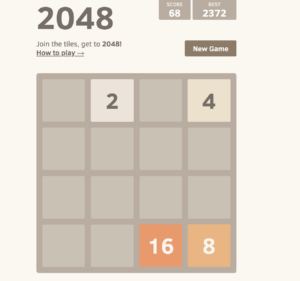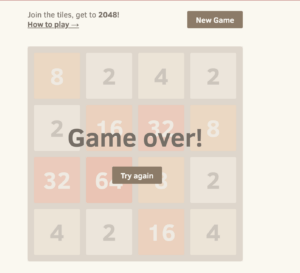I recently played a casual puzzle game called 2048 on the website play2048.co. It was created by Gabriele Cirulli and is available for both Desktop and mobile devices in iOS and Android. The objective of the game is to put two tiles together that contain the same number (all multiples of 2), until it’s sum reaches 2048, before the grid fills up with tiles. The game’s target audience includes users who are a minimum of 12 years old, who enjoy puzzle games and are looking for a quick and addictive challenge. As I started playing, I noticed the game’s formal elements, which include the mechanism that I could slide the tiles in four directions – up, down, left, and right – to merge them and make progress. The key dynamic of the game is that every time you move a tile in any direction, a new random tile will appear. These two elements create the primary aesthetic of challenge and expression. There is a big challenge which is that the bigger the numbers are closer to 2048, the harder they are to combine together, since you are only allowed to combine two equal numbers in value. I recall getting to 1028 so many times but not being able to merge it with another tile as big! Expression comes in because you can combine the smaller tiles in so many ways that favor how the space is distributed. You want to open as much space as possible, and there are so many ways of going at it.

2048 aims to be a fun and addictive game, and I must say it met its goals quite well. The game was easy to understand, but it proved to be challenging to master. As I played, I experienced moments of success when I strategically merged several high-numbered tiles, jumping closer to the coveted 2048 tile. These moments were incredibly satisfying and kept me engaged and motivated to continue playing. However, there were also times when I made a wrong move, filling up the grid and preventing me from making further progress. These epic fails were frustrating, but they also pushed me to improve my skills and try different strategies.
While the game was already quite enjoyable, I couldn’t help but think of a few ways to make it even better. One improvement would be the addition of different game modes or levels of difficulty to cater to different players’ preferences. It would add variety and provide new challenges for those who have mastered the original game. Additionally, some visual customization options would be a nice touch, allowing players to personalize the appearance of the tiles or the background according to their preferences. Lastly, integrating a multiplayer feature where I could compete with friends or other players online would add another layer of excitement and friendly competition to the game. Overall, 2048 is a simple yet captivating puzzle game that provides a fun and addictive gameplay experience, and with a few additions and tweaks, it could become even more engaging.




